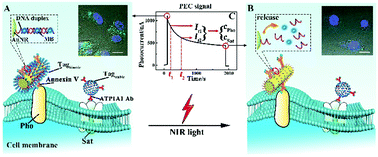A near-infrared light-controlled, ultrasensitive one-step photoelectrochemical detection of dual cell apoptosis indicators in living cancer cells†
Abstract
Here, a near-infrared (NIR) light-controlled, ultrasensitive one-step photoelectrochemical (PEC) strategy was constructed to simultaneously detect cell apoptosis indicators, phosphatidylserine (Pho) and sodium–potassium adenosine triphosphatase (Sat), on living cancer cells. Using NIR light as excitation, the signal probe methylene blue (Tagkinetic) could be released, leading to a gradually decreased photocurrent signal Ikinetic; meanwhile, the photocurrent Istable of the signal probe carbon quantum dots (Tagstable) remained stable. The simultaneous detection of Pho and Sat could be achieved based on rapid one-step PEC detection under single NIR light with the assistance of a smart signal decryption strategy with Ikinetic and Istable. Importantly, this proposal provides more effective drug candidates with milder pharmaceutical effect but improved safety.



 Please wait while we load your content...
Please wait while we load your content...